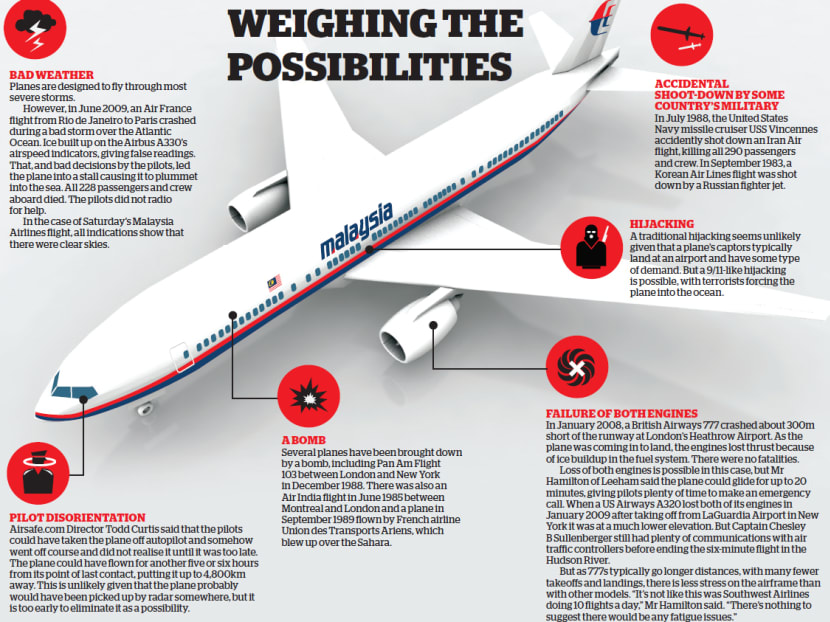Catastrophe, or a criminal act, say experts
NEW YORK — The most dangerous parts of a flight are the takeoff and landing. Rarely do incidents happen when a plane is cruising 11km above the earth.
NEW YORK — The most dangerous parts of a flight are the takeoff and landing. Rarely do incidents happen when a plane is cruising 11km above the earth.
So the disappearance of Malaysia Airlines flight MH370 well into its flight on Saturday morning over the Gulf of Thailand has led aviation experts to assume that whatever happened was quick and left the pilots no time to place a distress call.
It could take investigators months, if not years, to determine what happened to the Boeing 777 flying from Kuala Lumpur to Beijing.
“At this early stage, we’re focusing on the facts that we don’t know,” said Mr Todd Curtis, a former safety engineer with Boeing who worked on its 777 planes and is now Director of the Airsafe.com Foundation.
If there was a minor mechanical failure — or even something more serious like the shutdown of both of the plane’s engines — the pilots probably would have had time to radio for help. The lack of a call “suggests something very sudden and very violent happened”, said Professor William Waldock, who teaches accident investigation at Embry-Riddle Aeronautical University in Arizona.
It initially appears that there was either an abrupt breakup of the plane or something that led it into a quick, steep dive. Some experts even suggested an act of terrorism or a pilot purposely crashing the jet.
“Either you had a catastrophic event that tore the airplane apart, or you had a criminal act,” said Mr Scott Hamilton, Managing Director of aviation consultancy Leeham. “It was so quick and they didn’t radio.”
No matter how unlikely a scenario, it is too early to rule out any possibilities, experts warn. The best clues will come with the recovery of the flight data and voice recorders and an examination of the wreckage.
Airplane crashes typically occur during takeoff and the climb away from an airport, or while coming in for a landing, as in last year’s fatal crash of an Asiana Airlines jet in San Francisco. Only 9 per cent of fatal accidents happen when a plane is at cruising altitude, according to a statistical summary of commercial jet airplane accidents done by Boeing.
Capt John M Cox, who spent 25 years flying for US Airways and is now CEO of Safety Operating Systems, said that whatever happened to the Malaysia Airlines Boeing 777 jet — a model with one of the best safety records in aviation history, having gone 18 years without a fatal accident prior to the Asiana crash — it occurred quickly.
The problem had to be big enough, he said, to stop the plane’s transponder from broadcasting its location, although the transponder can be purposely shut off from the cockpit.
One of the first indicators of what happened will be the size of the debris field. If it is large and spread out over tens of kilometres, then the plane probably broke apart at a high elevation. That could signal a bomb or a massive airframe failure. If it is a smaller field, the plane probably fell intact, breaking up upon contact with the water.
“We know the airplane is down. Beyond that, we don’t know a whole lot,” Capt Cox said. AP







